Agricultural Sciences
Vol.4 No.1(2013), Article ID:27407,8 pages DOI:10.4236/as.2013.41002
Approximation of some minerals in soil and forage as a function of non-conventional compost: A case study
![]()
1Department of Biological Sciences, University of Sargodha, Sargodha, Pakistan
2 Livestock Production & Management, Animal Husbandry Economics, Animal Science Research Institute of Iran, Karaj, Iran; *Corresponding Author: farmir2001@gmail.com
3Department of Chemistry, University of Sargodha, Sargodha, Pakistan
4Department of Animal Sciences, University of Sargodha, Sargodha, Pakistan
5Division of Science and Technology, University of Education, Lahore, Pakistan
Received 5 October 2012; revised 22 November 2012; accepted 19 December 2012
Keywords: Mineral; Forage; Soil; Non-Conventional Fertilizer
ABSTRACT
In present study concentration of some metals (Magnesium, Nickel and Calcium) were determined in soil and different parts of Avena sativa treated with poultry waste grown in the pots. Nine different treatments of poultry waste were used: 0 (control), 60, 90, 120 and 150 kg/ha applied to soil as full doses before sowing, and 60, 90, 120, and 150 applied as two equal splits, 1st before sowing and the 2nd before flower instigation. The samples of soil were obtained after mixing the poultry waste with soil in each pot before sowing. Different parts (roots, leaves, and seeds) of plants were taken after 90 days of sowing and after grain filling. Samples of soil and forages were analyzed. Mg concentrations found both in soil and plants were non-significantly affected by treatments and were lower than the requirements of ruminants in forage crops, but above requirement of forages in soil. Soil and forage Ni was affected non-significantly from the treatments of poultry waste and soil and forage Ni levels were found to be lower than the toxic level for animals and forages. Soil Ca was affected non-significantly by treatments having far lower values than the requirements of both forage species and ruminants. The study showed that soil Mg was higher and Ca was lower than the requirements of forages, but forage Mg and Ca were not fulfilling the requirements of livestock indicating the non significant effect of poultry waste on their concentrations. From the results of this study it has been anticipated that various deficiency problems in livestock may be resulted as these elements play very important role in animals’ metabolic progression. Therefore, soil amendment with poultry manure along with other synthetic fertilizers for enhancing the levels of various minerals is acceptable. The soil amendment and specifically tailored mineral mixture with appropriate proportion of these elements is the dire needs for livestock consuming Avena sativa in pasture treated with poultry waste.
1. INTRODUCTION
In Pakistan, due to over population, the high rates of using chemicals disrupt the natural balance of the environment and human health. In this sense, natural resources, such as water, soil conservation and productivity by natural sustainability are important. In this regard, organic fertilizers are considered important. Organic material such as farmyard manure improves soil physical and chemical properties that are important for plant growth [1]. Organic fertilizers has positive effect on root growth by improving the root rhizosphere conditions (structure, humidity, etc.) and also plant growth is encouraged by increasing the population of microorganisms [2]. Organic fertilizers contain plant nutrients. Organic acids which occur in decomposition increases the benefits of nutrients [3]. In several studies, the effects of fertilization on yield and quality of onion were investigated. Kumar et al. [4] found that application of 120 kg N/ha increases onion yield to 30%. Rumpel [5] investigated the effect of 20, 40 and 60 t/ha animal manure doses, NPK (75:50:100 kg/ha) inorganic fertilizer and combination of them. Researchers have found that addition of animal manure resulted in higher onion yield compared to NPK fertilizer. 0%, 50% and 150% of the recommended amounts of NPK fertilizers (125:33:50 kg/ha) with 0, 10 and 20 t/ha manure combination have increased onion yield and nutrient uptake [6]. Mixture of chicken manure and bio fertilizer increases the yield of onion and enriched nutrient content in tuber was reported by Shaheen et al. [2]. Poultry litter can be used to fertilize all types of pasture. The best results are obtained from mixed pastures comprising grasses and legumes. Grasses generally have a vigorous root system able to extract enough potassium from the soil. Pastures that have been fertilized with poultry litter are intended to produce large amounts of high quality forage. Correct application of poultry litter to crop or pasture land is critical to maximize its fertilizer value and avoid creating environmental problems. The method suggested determining application rate poultry litter is to compare the best available estimates of nitrogen, phosphorus and potassium contained in the litter with what it would cost to buy the same nutrients in commercial fertilizers. New and innovative methods of utilizing litter continue being researched, but land application of litter remains the most common use. Litter contains essential nutrients for plant growth. It also contains organic matter that improves soil characteristics. For both of the above named reasons, there is rising interest in eastern Arkansas in using poultry litter as a soil fertilizer. While the fertilizer value of litter is well recognized, the nutrient concentration of litter can be extremely variable depending on a variety of factors. Yet without correctly sampling and analyzing litter before it is spread, there is no way to know its fertilizer value. In addition, soil testing is necessary if land application of litter is to be done accurately. Regular analysis of both litter and soil are important parts of the Best Management Practices program on your farm.
Although poultry litter is one of the best organic fertilizer sources available (Wilkinson), excessive applications of litter (as with any fertilizer source) can cause environmental problems. The main objective of this investigation was to study the effect of different levels of organic fertilizers on the yield, quality and macro-micro element content of forage plants consumed by ruminants treated with these non conventional fertilizers.
2. MATERIALS AND METHODS
This experimental work was conducted during December 2008 to April, 2009 at the University of Sargodha, Pakistan, which falls under semi-arid climatic conditions. Avena sativa seeds were sown in the first week of December 2008 in pots filled with loamy soil at a rate of 10 seeds per pot. The climatic conditions during the experiment were: 18˚C - 25˚C/10˚C - 17˚C day/night temperature, 55% - 60% RH and 12-hour photoperiod. Bulk poultry litter was a mixture of manure, bedding material and water. The proportion of each would vary depending on shed management. Poultry litter containing dead birds or parts of birds should not be spread on pasture to ensure that dead birds or feathers are not eaten by stock, and because of the risk of botulism in stock grazing that pasture. As a normal safety precaution, the bedding material was checked for presence of chemicals that could cause a residue problem in livestock that might graze littered areas. Poultry waste was added to the soil contained in the pots before sowing and/or before flower initiation. Split doses were applied twice, 1st just after sowing and 2nd at an interval of one month before flowering .While full dose was applied at once before sowing. The detail of varying poultry waste treatments has been given in Table 1. The complete randomized design (CRD) was used in this study. Polythene pots were used for sowing the seeds of plant and each plastic pot containing 7 kg soil was lined with polyethylene bag. Different parts of plants were harvested at maturity. Five replicates of plants from each dose were taken. All protective measures were adapted to make certain a good crop health. All the pots were irrigated with tap water throughout the experimental period.
2.1. Soil and Plants
Samples of each soil and plants were taken randomly from pots that were given different doses of urea. The samples of soil were obtained after mixing the poultry waste with soil in each pot before sowing. Harvest of different parts (root, stem, leaves and pods) of plants was taken after 90 days of sowing after grain filling. All plant samples were washed well with distilled water. These samples were then air-dried, stored in labelled sealed paper bags and placed in an oven for drying for three days at 70˚C.
2.2. Wet Digestion and Analysis
One gram air and oven dried soil and plant samples
Table 1. Different treatments of poultry waste applied to soil before and after sowing the forage crop.

were transferred to digestion tubes and 5 mL of H2SO4 were added to each tube. All tubes were then incubated overnight at room temperature. Then H2O2 (25 mL) was poured down through the sides of the digestion tubes which were placed on a hot plate to heat them until the complete digestion of the material. The volume of the extract was made up to 50 mL with distilled water. After filtering the extract, it was used for the analysis of metals concentration. The contents of calcium, magnesium, and nickel in soil and plant parts were determined using an atomic absorption spectrophotometer (Model#AA-6300, Shimadzu, Japan).
2.3. Statistical Analysis
The data obtained from all analyses was tested for significance at 0.05, 0.01 and 0.001 by using the software SPSS [7]. Standard error values were worked out to compare the mean values of each attribute.
3. RESULTS AND DISCUSSION
3.1. Soil Mg
There was non-significant treatments effect (P > 0.05) on Mg concentration of soil (Table 2). The lowest level of soil Mg was observed at T7 whereas the highest level of Mg concentration was found during T3. Regular increase in soil Mg was observed from 1st treatment to last one (Figure 1). The concentration of Mg ranged from 227.92 to 190.45 mg/kg during all treatments. In the present study soil Mg concentration is higher than those reported earlier [8,9]. All the soil samples analyzed were above the critical level of 30 mg/kg for Mg concentration [10].There seemed no need of soil amendment with synthetic fertilizer as poultry manure enhanced the soil Mg levels.
3.2. Forage Mg
Analysis of variance showed that Mg concentration has non-significant (P > 0.05) effect of the treatments of poultry manure (Table 2). The values ranged from 0.020535% to 0.015846% dry weight of forage. Lowest Mg concentration was found at T6 in leaf and highest Mg concentration was observed at T6 and T7 in seed (Figures 2-4). The values of forage Mg found in present study are higher than the values reported earlier by Prabowo et al. [11] and lower than those values already reported by Fujihara et al. [12] and Khan et al. [13]. These Mg values found in forage were sufficiently lower for the requirements of ruminants suggesting the use of poultry manure in combination with synthetic fertilizers for soil and in turn forage enhancement with respect to Mg level. The ruminants rearing on forage grown in soil amended with poultry manure should be provided mineral mixture with higher amounts of Mg to fulfil the requirements of this element and to prevent the animals from grass tetanic.
Table 2. Analysis of variance for Mg concentrations in soil, leaf, seed and root various treatments.

ns = non significant
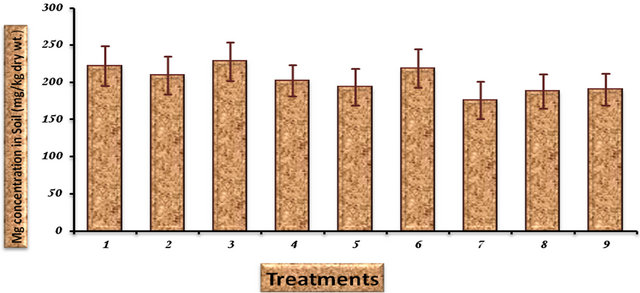
Figure 1. Variations in level of magnesium in Soil for various treatments.
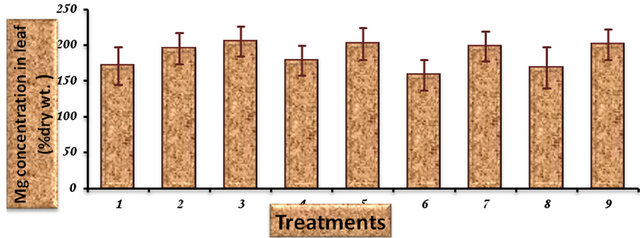
Figure 2. Variations in level of magnesium in leaf for various treatments.
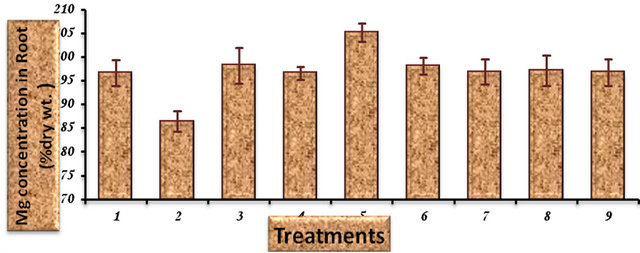
Figure 3. Variation in levels of magnesium in root for various treatments.
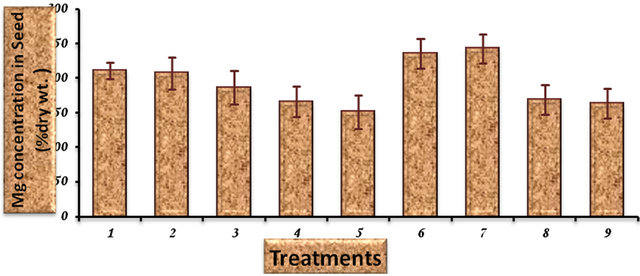
Figure 4. Variations in level of magnesium in seed for various treatments.
3.3. Soil Ni
The concentration of Ni in soil showed non significant affect (P > 0.05) of the treatments with poultry waste (Table 3). Ni concentration in soil ranged from 4.39 to 2.34 mg/kg across different treatments. Lowest value of soil Ni concentration was found by T9 and the highest by T2 (Figure 5). The values of soil Ni found during present study were lower than the critical values of 0.85 mg/kg as reported by Adriano [14]. These soil Ni concentrations are far lower than the value reported previously by Berrow and Reaves [15] in Scotland who found a geometric mean concentration of nickel in soil of 27 mg/kg. So soil Ni values found in the present investigation were far low than the toxic level for plants grown therein.
3.4. Forage Ni
There was a non significant (P > 0.05) effect on Ni concentration of various treatments of poultry manure (Table 3). The concentration of nickel in forage ranged from 1.49 to 2.90 mg/kg. Forage Ni concentration was found to be highest in T9 in seed and least at T3 in leaf in present study (Figures 6-8). However, these values were more than the critical level of 0.01 mg/kg reported by NRC [16]. Forage Ni concentration found in our study is lower than the concentration already reported by Khan et al. [17] in Pakistan and Espinoza et al. [18] in Florida. These concentrations are also lower than the values reported by Rahman et al. [19]. It has been demonstrated that there are different factors that result in the absorption of Ni in livestock and Ni deficiency is most limiting element for ruminants in various regions of the world.
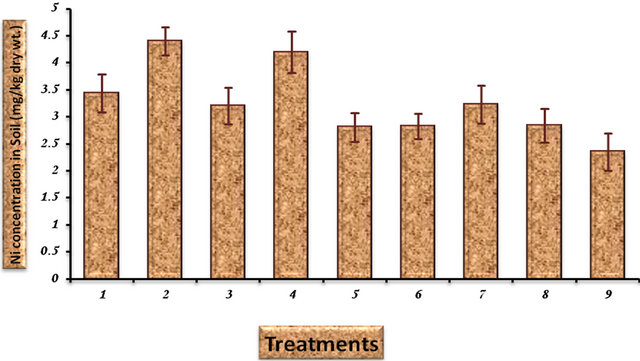
Figure 5. Variations in level of nickel in soil for various treatments.
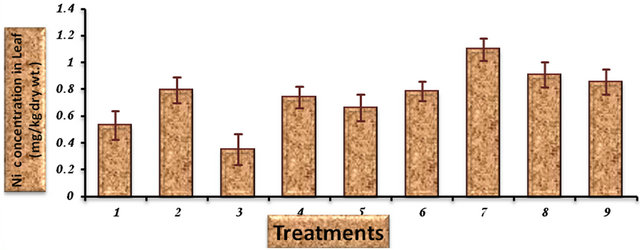
Figure 6. Variation in levels of nickel in leaf for various treatments.
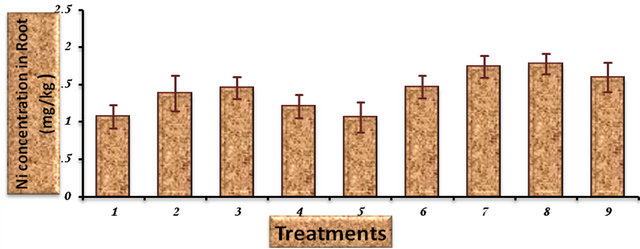
Figure 7. Variations in level of nickel in root for various treatments.
3.5. Soil Ca
There was non-significant treatments effect (P > 0.05) on Ca concentration of soil (Table 4). The lowest level of soil Ca was observed at T4 whereas the highest level of Mg concentration was found at T6. Soil Ca values inconsistently increased or decreased with the treatments (Figure 9). The concentration of Ca ranged from 24.43 to 21.75 mg/kg during all treatments. The mean concentration of Ca is lower than the critical values of 71 mg/kg as reported by McDowell [20]. The values obtained during present findings are lower than the values reported by Li et al. [21]. Soil type, drainage, liming, and cropping practices affect the levels of calcium found in the soil.
Calcium is closely related to soil pH which plays an important role in its availability and absorption by the plants [22].
3.6. Forage Ca
Analysis of variance showed that Ca concentration was affected (P > 0.05) non-significantly by the treatments of poultry excreta (Table 4) in root, leaf and seed. The values ranged from 0.002767% to 0.002454% in root and seed while it ranged from 27.49 to 21.47 mg kg–1 in leaf tissue (Figures 10-12). Lowest Ca concentration in root was found at T5 and highest was observed at T2 in root. While in case of leaf the highest values were
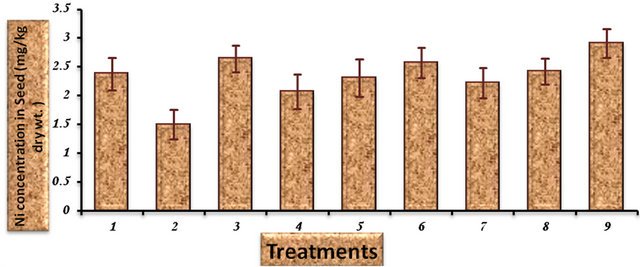
Figure 8. Variations in level of nickel in seed for various treatments.
Table 3. Analysis of variance for Ni concentrations in soil, leaf, seed and root various treatments.

ns = non significant
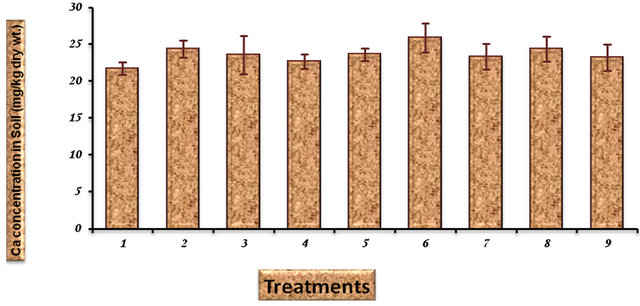
Figure 9. Variation in level of calcium in soil for various treatments.
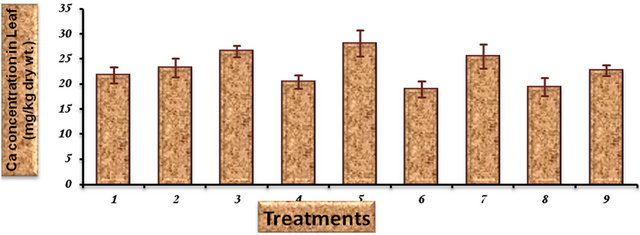
Figure 10. Variation in level of calcium in leaf for various treatments.
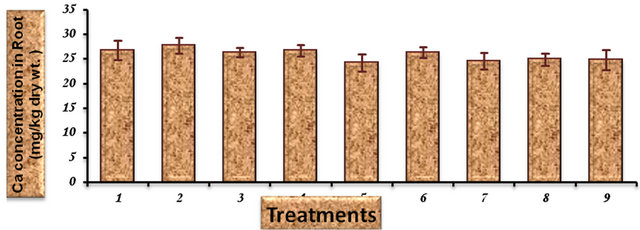
Figure 11. Variation in level of calcium in root for various treatments.

Figure 12. Variation in level of calcium in seed for various treatments.
Table 4. Analysis of variance for Ca concentrations in soil, leaf, seed and root various treatments.

ns = non significant observed at T5 and the lowest at T6 with gradual increase or decrease. Average forage Ca concentration found in this investigation is much lower than reported previously in Pakistan [22,23] and in Columbia, [24] and similar with those reported by Rojas et al. [25] in Venezuela. These low forage Ca values imply that the grazing livestock were not subjected to good quality forages; therefore the livestock should be continually supplied mixture with higher amount of Ca to prevent various problems due to deficiency of this particular element.
![]()
![]()
REFERENCES
- Snyman, M.A., Erasmus, G.J., van Wyk, J.B. and Olivier, J.J. (1998) Genetic and phenotypic correlations among production and reproduction traits in Afrino sheep. South African Journal of Animal Sciences, 28, 74-81.
- Shaheen, A., Fatma, M., Rizk, A. and Singer, S.M. (2007) Growing onion plants without chemical fertilization. Research Journal of Agriculture Biological Sciences, 3, 95- 104.
- Anonymous (2010) http://www.apps.fao.org/
- Kumar, A., Singh, R. and Chhillar, R.K. (2001) Influence of nitrogen and potassium application on growth, yield and nutrient uptake by onion (Allium cepa L.). Indian Journal of Agronomy, 46, 742-746.
- Rumpel, J. (1998) Effect of long-term organic, mineral, and combined organic-mineral fertilization on yield of onions (Allium cepa L.) grown from seeds. Biuletyn Warzywniczy, 48, 5-15.
- Sharma, R.P., Datt. N. and Sharma, P.K. (2003) Combined application of nitrogen, phosphorus, potassium and farmyard manure in onion under high hills, dry temperate conditions of north-western Himalayas. Indian Journal of Agricultural Sciences, 73, 225-227.
- Steel, R.G.D. and Torrie, J.H. (1986) Principles and procedures of statistics: A biometrical approach. 2nd Edition, McGraw Hill Co. Inc., New York.
- Cuesta, P.A., McDowell, L.R., Kunkle, W.E., Bullock, F., Drew, A., Wilkinson, N.S. and Martin, F.G. (1993) Seasonal variation of soil and forage mineral concentrations in north Florida. Communications in Soil Science and Plant Analysis, 24, 335-347. doi:10.1080/00103629309368803
- Tiffany, M.E., McDowell, L.R., O’Connor, G.A., Nguyen, H., Martin, F.G., Wilkinson, N.S. and Katzowitz, N.A. (2001) Effects of residual and reapplied biosolids on forage and soil concentrations over a grazing season in north Florida. II. Micro minerals. Communications in Soil Science and Plant Analysis, 32, 2211-2226. doi:10.1081/CSS-120000278
- Rhue, R.D. and Kidder, G. (1983) Analytical procedures used by the IFAS extension soil laboratory and the interpretation of results. Soil Science Department, University of Florida, Gainesville.
- Prabowo, A., McDowell, L.R., Wilkinson, N.S., Wilcox, C.J. and Cornad, J.H. (1990) Mineral status of grazing cattle in South Sulawesi, Indonesia; I. Macrominerals. American Journal of Animal Science, 4, 111-120.
- Fujihara, T., Matsui, T., Hayashi, S., Robles, A.Y., Serra, A.B., Cruz, L.C. and Shimizu, H. (1992) Mineral status of grazing Philipine goats. II the nutrition of selenium, copper and zinc of goats in Luzon Island. Asian-Austranian Journal of Animal Sciences, 5, 389-395.
- Khan, Z.I., Ahmed, K., Ashraf, M., Valeem, E.E. and McDowell, L.R. (2009) Mineral status of forage and its relationship with that of plasma of farm animals in Southern Punjab, Pakistan. Pakistan Journal of Botany, 41, 67-72.
- Adriano, D.C. (1986) Trace elements in the terrestrial environment. Springer, New York. doi:10.1007/978-1-4757-1907-9
- Berrow, M.L. and Reaves, G.A. (1986) Total chromium and nickel contents of Scottish soils. Geoderma, 37, 15- 27. doi:10.1016/0016-7061(86)90040-6
- National Research Centre (NRC) (1984) Nutrient requirements of beef cattle. 6th Revised Edition, Nutrient Requirements of Domestic Animals, No. 4, National Academy of Science, National Research Council, Washington DC.
- Khan, Z.I., Ashraf, M. and Hussain, A. (2007) Evaluation of manganese status of grazing sheep in a semi-arid region of Pakistan. Trace Elements & Electrolytes, 24, 55- 60.
- Espinoza, J.E., McDowell, L.R., Wilkinson, N.S., Conrad, J.H. and Martin, F.G. (1991) Monthly variation of forage and soil minerals in Central Florida-II. Trace minerals. Communications in Soil Science and Plant Analysis, 22, 1137-1149. doi:10.1080/00103629109368480
- Rahman, M.M., Kincaid, R.L. and Elzubeir, E.A. (1998) Mineral deficiencies in grazing dairy cattle in Kordofan and Darfur regions in Western Sudan. Tropical Animal Health and Production, 30, 123-135. doi:10.1023/A:1005051902115
- McDowell, L.R. (1985) Nutrition of grazing ruminants in warm climates. Academic Press, New York, 443.
- Li, Z.H., Xu, A.G. and Long, H.Y. (2004) Evaluation of soil nutrient conditions in major tobacco-producing region of China. Science Agricultural Sinica, 37, 36-42.
- Khan, Z.I., Hussain, A. Ashraf, M., Valeem, E.E. and Javed, L. (2005) Evaluation of variation of soil and forage minerals in pasture in a semiarid region of Pakistan. Pakistan Journal of Botany, 37, 921-931.
- Khan, Z.I., Hussain, A., Ashraf, M. and McDowell, L.R. (2006) Mineral status of soils and foragesin southwestern Punjab-Pakistan: Micro-minerals. Asian-Austraasian Journal of Animal Sciences, 19, 1139-1147.
- Pastrana, R., McDowell, L.R., Conrad, J.H. and Wilkinson, N.S. (1991) Macromineral status of sheep in the Paramo region of Colombia. Small Ruminant Research, 5, 9-21. doi:10.1016/0921-4488(91)90026-M
- Rojas, L.X., McDowell, L.R., Wilkinson, N.S. and Martin, F.G. (1993) Mineral status of soils, forages, and beef cattle in South East Venezuela. I. Macro-minerals and forage organic constituents. International Journal of Animal Sciences, 8, 183-188.

